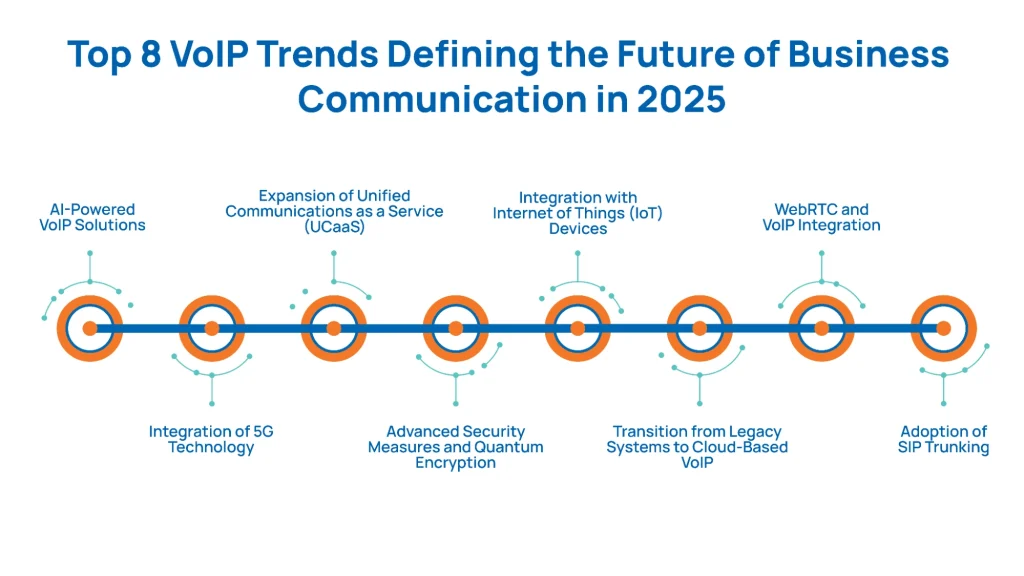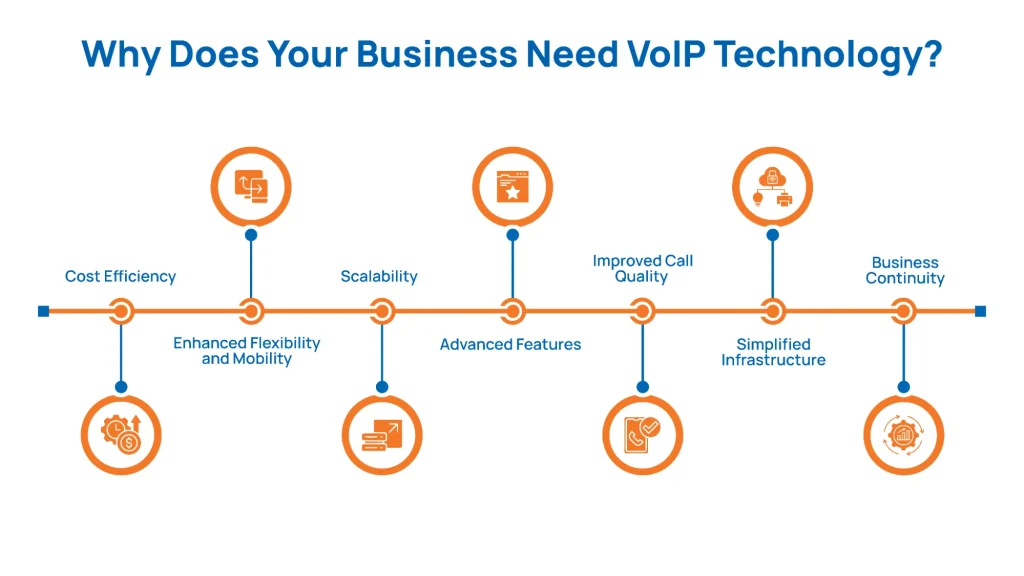Key Takeaways:
|
Top 8 VoIP Trends Defining the Future of Business Communication in 2025
 Below are the eight most important VoIP trends and innovations to watch in 2025. Each offers unique opportunities to improve performance, boost collaboration, and future-proof your communication strategy.
Below are the eight most important VoIP trends and innovations to watch in 2025. Each offers unique opportunities to improve performance, boost collaboration, and future-proof your communication strategy.
-
AI-Powered VoIP Solutions
-
Integration of 5G Technology
-
Expansion of Unified Communications as a Service (UCaaS)
-
Advanced Security Measures and Quantum Encryption
5. Integration with Internet of Things (IoT) Devices
The convergence of VoIP and IoT technologies is transforming communication across various sectors. Integrating VoIP with IoT devices allows for real-time communication between machines and systems. In smart homes, voice commands control lighting, temperature, and security systems. In industrial settings, sensors can trigger VoIP alerts to notify personnel of equipment anomalies. Remote patient monitoring devices can alert healthcare providers via VoIP calls when critical thresholds are crossed. IoT sensors on machinery can initiate VoIP notifications for maintenance teams upon detecting irregularities. Smart home systems use VoIP to facilitate communication between devices, enabling users to manage their homes remotely.-
Transition from Legacy Systems to Cloud-Based VoIP
-
WebRTC and VoIP Integration
-
Adoption of SIP Trunking
Why Does Your Business Need VoIP Technology?
 Integrating Voice over Internet Protocol (VoIP) into your business communication infrastructure offers numerous advantages that can enhance efficiency, reduce costs, and support scalability. Here are a few of these benefits:
Integrating Voice over Internet Protocol (VoIP) into your business communication infrastructure offers numerous advantages that can enhance efficiency, reduce costs, and support scalability. Here are a few of these benefits:
1. Cost Efficiency
VoIP significantly reduces communication expenses by utilizing internet connections for calls, eliminating the need for traditional phone lines. Businesses can save on long-distance and international call charges and infrastructure and maintenance costs associated with conventional phone systems.2. Enhanced Flexibility and Mobility
VoIP enables employees to make and receive calls from anywhere with an internet connection, supporting remote work and mobile operations. This flexibility ensures continuous communication, regardless of location, and facilitates a more adaptable workforce.3. Scalability
As your business grows, VoIP systems can easily scale to accommodate additional users or features without significant infrastructure changes. This scalability allows for seamless expansion and adaptation to evolving business needs.4. Advanced Features
VoIP services often have advanced features such as call forwarding, voicemail-to-email, video conferencing, and integration with other business applications. These tools enhance communication efficiency and collaboration within the organization.5. Improved Call Quality
With a stable internet connection, VoIP can offer superior call quality compared to traditional phone lines. High-definition audio and reduced latency contribute to more transparent and more reliable communication.6. Simplified Infrastructure
VoIP consolidates voice and data networks, reducing the complexity and cost of maintaining separate systems. This integration streamlines IT management and can lead to further operational efficiencies.7. Business Continuity
In the event of disruptions such as power outages or natural disasters, VoIP systems can reroute calls to alternative devices or locations, ensuring uninterrupted communication and business operations. By adopting VoIP technology, your business can modernize its communication systems, leading to improved performance, reduced costs, and greater adaptability in an increasingly digital and connected world.Drive Growth with PerfectSoft.AI’s Intelligent VoIP & Contact Center
 At PerfectSoft.AI, we deliver intelligent, high-performance contact center solutions to improve customer satisfaction, boost agent productivity, and streamline operations.
Whether you manage a large-scale BPO, a customer service department, or an outbound sales team, our technology helps you stay connected across all channels while ensuring crystal-clear
We provide advanced VoIP-based Telecom Voice Services that guarantee:
At PerfectSoft.AI, we deliver intelligent, high-performance contact center solutions to improve customer satisfaction, boost agent productivity, and streamline operations.
Whether you manage a large-scale BPO, a customer service department, or an outbound sales team, our technology helps you stay connected across all channels while ensuring crystal-clear
We provide advanced VoIP-based Telecom Voice Services that guarantee:
- High-Quality Voice Calls – Clear and uninterrupted voice communication.
- Reliable Connectivity – Stable and secure connections across all regions.
- Global Reach – Seamless communication with teams and customers worldwide.


Comments